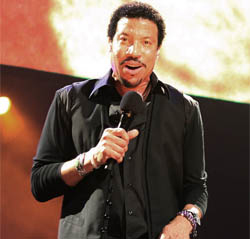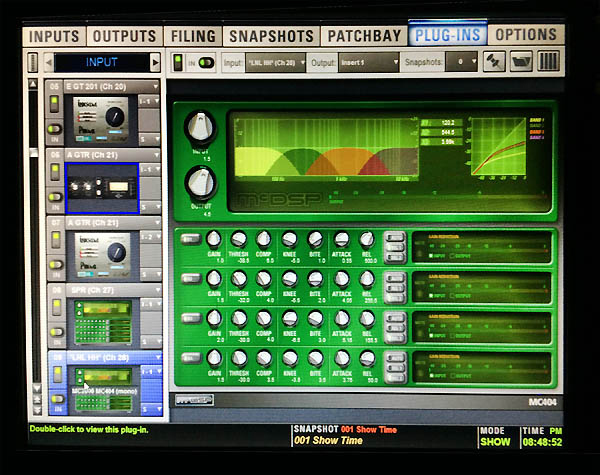
Serving The Ethic
In addition to Richie, four of the members of Richie’s five-piece band sing backup vocals, all using SM58s with the exception of Dino Soldo, who’s on a Crown CM311 headworn mic.
“He plays all the wind and utility instruments so he uses the CM311 with a Shure RF system, which makes it easier for him as some of his vocal passages come up just after saxophone sections. But the MC2000 is applied to everyone’s vocal chain,” Housel says. “That’s all I use. Previously, I was using a Fairchild 660 plug-in stacked with an 1176 to ‘peg’ the final output for the vocals.”
Housel had employed a similar setup with Keenan’s bands previously, but the band noticed a bit of latency so he switched to the MC2000. “I didn’t hear it, but it’s the job of an engineer to work harder to produce a better product for people because we have such great tools available. It’s a musician thing,” he says, referencing his work as a guitar player in the past. “You want to keep learning and get better.”
He’s also made a variety of mic changes for the band in service of that ethic, including Sennheiser 904s on drummer Oscar Seaton’s toms. “To me, it sounds like a Sennheiser 421,” Housel notes. “It’s got the boom and the transient attack, but unlike a 421 I can put it within a very small, confined area.”
Kick in and out are handled with a Shure BETA 91A and beyerdynamic M88, respectively. Snare is captured with SM57 on top and a BETA 57 on bottom, with a second snare covered by an additional SM57. Neumann KM 184s are applied for hi-hat and ride, with AKG C414 XLS multi-pattern condensers for overheads.

Housel has moved from a combination of ribbon and condenser mics to a pair of dynamics – SM57 and beyerdynamic M201 – for guitarist Ben Mauro. “I like those for their frequency response, to my ear, in terms of what a guitar should sound like,” he explains. “On the console EQ I use a lot of high-pass and low-pass to narrow in on what the actual guitar sound is without having to go in and boost, say, somewhere in the mid band from 600 Hz to 1 kHz. Low end isn’t necessarily a guitar player’s friend, but if there’s too much high end you’re going to have an endless battle between hi-hat, kick, snare and guitar, which is what many guitarists have blazing in their mixes.”
Big Compliments
There’s also a good deal of direct (box) action on stage, the domain of more Radial gear. J48s handle acoustic guitar and bassist Ethan Farmer’s rig, with JDI Duplex passive boxes for keyboardist/MD Chuckii Booker, keyboardist/sax player Dino Soldo and Richie’s piano, a Nord Stage in a slim grand chassis.
“On bass I’m also using a Radial SGI re-amp module because we’re a long distance from the receiver of the wireless to the stage, and he’s got an octave pedal and a local tuner I’ve got to catch,” Housel adds. “The RF receivers for his bass are all the way stage right. When I first came on, the tech had a long 1/4-inch cable that he was putting in a loom.”
Audio-Technica ATM35 cardioid condensers are utilized with Soldo’s alto and tenor saxes, with another SM57 for his soprano sax and an SM58 for his harmonica. The mic package is completed with four Sennheiser MKH 50s deployed in L/R and L/R/C to capture audience ambiance.
All performers wear Ultimate Ears in-ear monitors, ranging from UE 11s to UE 18s, with signal delivered via Shure PSM 1000 personal monitoring systems. “I also carry six Clair 12AM active stage monitors for emergencies, all downstage and on a single mix,” he says, noting that Clair Brothers is serving as the tour’s sound company. “But in two years, I’ve turned them on maybe twice.”
The stage is also outfitted with two Clair “bowtie” dual-18 subs, one per side, and eight CO8s, four per side, as side fills, receiving a mono mix of kick, snare, toms and bass. “I try to use as few sources as possible that might interface with Lionel’s microphone when he wanders the stage,” he says, “and I want to stay out of the way of our house engineer’s mix, but while I’m mixing for a smaller audience, if they don’t have a good show, he’s not going to have a good show.”
Housel still considers the monitor rig a work in progress and is mulling over other possible changes, including a potential switch to a DiGiCo console. The overall mantra is achieving a balance between what the performers are comfortable with while trying to make things better for them in the long term.
“I got lucky with Lionel and the band,” he concludes. “My first gig was a fly date and I’d never met our tour manager, Glen Matthews, or the band. Then, our input list was mostly Shure products, which are known commodities to me, and their gain structure was a known thing to me. So we got the band on stage, I put up a quick mix, we went through a few songs, made a few changes, and the band came off after sound check and said, ‘Sounds great. Are you a musician? Because it’s really musical sounding.’ And that’s one of the biggest compliments I could ask for as an engineer.”
Based in Toronto, Kevin Young is a freelance music and tech writer, professional musician and composer.
